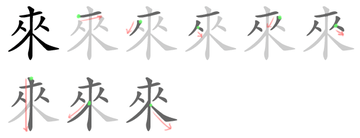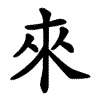來
| ||||||||
Translingual
| Traditional | 來 |
|---|---|
| Simplified | 来 |
| Japanese | 来 |
| Korean | 來 |
| Stroke order | |||
|---|---|---|---|
 | |||
| Stroke order | |||
|---|---|---|---|
 | |||
Han character
來 (radical 9, 人+6, 8 strokes, cangjie input 木人人 (DOO), four-corner 40908, composition ⿻木从)
Descendants
References
- KangXi: page 101, character 16
- Dai Kanwa Jiten: character 581
- Dae Jaweon: page 214, character 8
- Hanyu Da Zidian: volume 1, page 141, character 8
- Unihan data for U+4F86
Chinese
| trad. | 來 | |
|---|---|---|
| simp. | 来 | |
| variant forms | 𧼛 | |
Glyph origin
| Historical forms of the character 來 | |||||||||||||||||||||||||||||||||||||||||||||||||||||||||||||||||||||||||||||||||||||||||||||||||||||||||||||||||||||||||||||||||||||||||||||||||||||||||||||||||||||||||||||||||||||||||||||||||||||||||||||||||||||||||||||
|---|---|---|---|---|---|---|---|---|---|---|---|---|---|---|---|---|---|---|---|---|---|---|---|---|---|---|---|---|---|---|---|---|---|---|---|---|---|---|---|---|---|---|---|---|---|---|---|---|---|---|---|---|---|---|---|---|---|---|---|---|---|---|---|---|---|---|---|---|---|---|---|---|---|---|---|---|---|---|---|---|---|---|---|---|---|---|---|---|---|---|---|---|---|---|---|---|---|---|---|---|---|---|---|---|---|---|---|---|---|---|---|---|---|---|---|---|---|---|---|---|---|---|---|---|---|---|---|---|---|---|---|---|---|---|---|---|---|---|---|---|---|---|---|---|---|---|---|---|---|---|---|---|---|---|---|---|---|---|---|---|---|---|---|---|---|---|---|---|---|---|---|---|---|---|---|---|---|---|---|---|---|---|---|---|---|---|---|---|---|---|---|---|---|---|---|---|---|---|---|---|---|---|---|---|---|---|---|---|---|---|---|---|---|---|---|---|---|---|---|---|---|
| Shang | Western Zhou | Warring States | Shuowen Jiezi (compiled in Han) | Liushutong (compiled in Ming) | |||||||||||||||||||||||||||||||||||||||||||||||||||||||||||||||||||||||||||||||||||||||||||||||||||||||||||||||||||||||||||||||||||||||||||||||||||||||||||||||||||||||||||||||||||||||||||||||||||||||||||||||||||||||||
| Oracle bone script | Bronze inscriptions | Chu Slip and silk script | Small seal script | Transcribed ancient scripts | |||||||||||||||||||||||||||||||||||||||||||||||||||||||||||||||||||||||||||||||||||||||||||||||||||||||||||||||||||||||||||||||||||||||||||||||||||||||||||||||||||||||||||||||||||||||||||||||||||||||||||||||||||||||||
 |
 |
 |
 |
 | |||||||||||||||||||||||||||||||||||||||||||||||||||||||||||||||||||||||||||||||||||||||||||||||||||||||||||||||||||||||||||||||||||||||||||||||||||||||||||||||||||||||||||||||||||||||||||||||||||||||||||||||||||||||||
| |||||||||||||||||||||||||||||||||||||||||||||||||||||||||||||||||||||||||||||||||||||||||||||||||||||||||||||||||||||||||||||||||||||||||||||||||||||||||||||||||||||||||||||||||||||||||||||||||||||||||||||||||||||||||||||
|
References: Mostly from Richard Sears' Chinese Etymology site (authorisation),
| |||||||||||||||||||||||||||||||||||||||||||||||||||||||||||||||||||||||||||||||||||||||||||||||||||||||||||||||||||||||||||||||||||||||||||||||||||||||||||||||||||||||||||||||||||||||||||||||||||||||||||||||||||||||||||||
| Characters in the same phonetic series (來) (Zhengzhang, 2003) | |
|---|---|
| Old Chinese | |
| 來 | *m·rɯːɡ |
| 萊 | *rɯː, *rɯːs |
| 淶 | *rɯː |
| 徠 | *rɯː, *rɯːs |
| 崍 | *rɯː |
| 郲 | *rɯː, *ruːlʔ, *ruːlʔ |
| 騋 | *rɯː |
| 猍 | *rɯː |
| 鯠 | *rɯː |
| 鶆 | *rɯː |
| 庲 | *rɯː |
| 棶 | *rɯː |
| 斄 | *rɯː, *rɯ |
| 逨 | *rɯː, *rɯːs |
| 麳 | *rɯː |
| 唻 | *rɯːʔ, *rrɯː |
| 賚 | *rɯːs |
| 睞 | *rɯːs |
| 勑 | *rɯːs |
| 誺 | *rɯːs, *r̥ʰɯ, *r̥ʰɯs, *r̥ʰɯs |
| 倈 | *rɯ |
| 憖 | *ŋrɯns |
| 猌 | *ŋrɯns |
| 麥 | *mrɯːɡ |
Pictogram (象形) of wheat – original character of 麥 (OC *mrɯːɡ, “wheat”) or 麳 (OC *rɯː, “wheat”). The line in the middle represents the ear, the two lines pointing upwards represent leaves, and the lines pointing downwards represent the stem and roots. An additional horizontal line was often added at the top end of the character, possibly used to emphasize the ear of the wheat. Compare 禾.
This character has been borrowed for “to come” since the oracle bone script. During the Western Zhou and Warring States periods, additional semantic components, such as 止 (“foot”) or 辵 (“to walk”), were added to differentiate the original sense from the borrowed sense. However, these additions were not inherited in later scripts.
Some consider the derivative 麥 from the addition of 夊 (“to walk slowly”) to be the original form for the meaning “to come”. If so, their meanings have interchanged due to frequent use of 來 for “to come”.
Shuowen connects “wheat” and “to come” from a mythological standpoint: 天所來也 (“it comes from the heavens”). This may be supported by archaeological evidence, which suggests that wheat is not native to China, but originated in the Fertile Crescent.
來 and 麥 have both been reconstructed to begin with *mr- in Old Chinese. The former retains the liquid as /l/, while the latter retains the nasal /m/.
Etymology
From Proto-Sino-Tibetan *la-j ~ ra (“to come”).
Pronunciation
Definitions
來
- to come; to arrive
- Antonyms: 去 (qù)
- to happen; to occur
- to do (specific meaning depending on the context)
- since
- next; coming; future
- (after a number) about; approximately; around
- Used after a verb of motion to indicate movement toward the speaker.
- Used before a verb to express volition.
- Used with 不 or 得 to express capability.
- Used after numerals in colloquial lists.
- Meaningless particle for rhythmic purposes.
- A surname.
Synonyms
| Dialectal synonyms of 來 (“to come”) [map] | ||
|---|---|---|
| Variety | Location | Words |
| Classical Chinese | 來 | |
| Formal (Written Standard Chinese) | 來 | |
| Mandarin | Beijing | 來 |
| Cantonese | Guangzhou | 嚟 |
| Hong Kong | 嚟 | |
| Taishan | 來 | |
| Hakka | Meixian | 來 |
| Min Nan | Taipei | 來 |
| Kaohsiung | 來 | |
| Tainan | 來 | |
| Taichung | 來 | |
| Hsinchu | 來 | |
| Lukang | 來 | |
| Sanxia | 來 | |
| Yilan | 來 | |
| Kinmen | 來 | |
| Magong | 來 | |
| Chaozhou | 來 | |
| Shantou | 來 | |
Compounds
|
|
|
Further reading
- “Entry #3543”, in 臺灣閩南語常用詞辭典 [Dictionary of Frequently-Used Taiwan Minnan] (in Chinese and Min Nan), Ministry of Education, R.O.C., 2011.
Japanese
| 来 | |
| 來 |
Readings
Etymology 1
Etymology 2
Korean
Vietnamese
Han character
來 (lai, lay, lơi, ray, rơi, rời)
- This term needs a translation to English. Please help out and add a translation, then remove the text
{{rfdef}}.
























































































































































































































